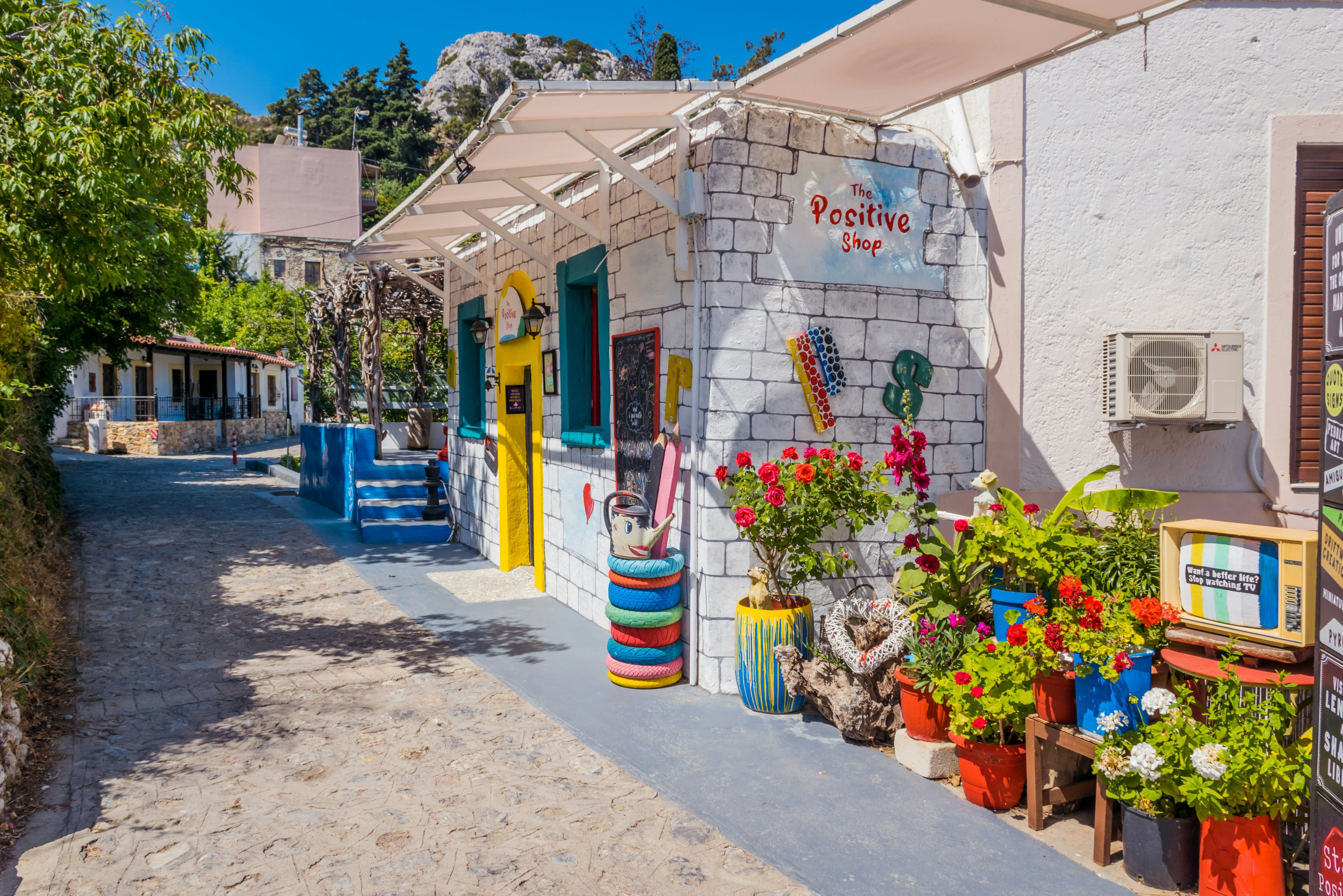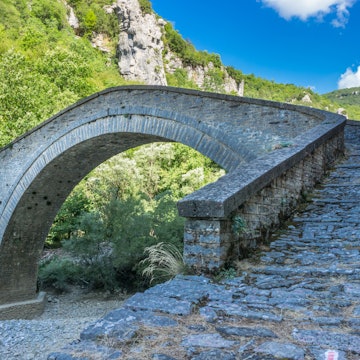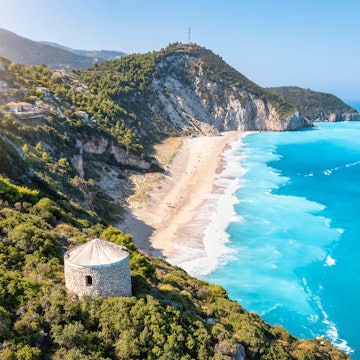

The Palace of Justice in Kos Town, the capital of the Greek Island of Kos. Franz Marc Frei/Getty Images
The third-largest island of the Dodecanese (after Rhodes and Karpathos), the beautiful island of Kos caters to everyone, including families and adrenaline junkies. It offers perfect beaches (one with hot springs), the ancient health sanatorium of Asklipieion, mountain villages surrounded by pine trees, tours of local honey and wine makers, and the alluring alleyways of Kos Town and villages. The island’s compact size – 26 miles by 7 miles (42km by 11km) – means you can easily get off the beaten track and explore its hilly spine. The island is easy to get around by car, bus and in parts, bicycle. Kos is an excellent jumping-off point for other islands in the Dodecanese and other island groups.
When should I go to Kos?
Like most of the Greek islands, Kos is busiest during high season (June to August) when beaches are packed and crowds are at their peak. That said, given the large permanent population that lives here, much of the island, particularly Kos Town, operates year-round. May, September and October are also appealing because of enjoyable ocean temperatures. Spring and fall are perfect for hiking and for basing yourselves in Kos Town when seaside resorts are no longer operating at full throttle.

How much time should I spend in Kos?
Kos is a destination island so you can easily fill a week or more. This gives you time to explore Kos Town and its captivating ruins and sites. Over the next three days you can delve into the island: venture 6 miles (10km) southwest of Kos Town and into the mountains to Haihoutes Cafe, a traditional kafeneion (coffee house); visit a winery; take a tour of a honey farm; and plunge into the superb seas off one of the island’s many beaches.
For a break from Kos, take a boat tour to nearby Nisyros (itself a beautiful destination) where you can spend the day wandering through Mandraki, the main village, before entering the “live” volcano – an extraordinary experience. (Spoiler: no lava, but wear heavy-soled shoes!)
Is it easy to get in and around Kos?
There are two ways to arrive in Kos – via air and via ferry. Kos Airport, 15 miles (24km) southwest of the city, is well-connected with other major Greek cities and islands. A handy public KTEL bus service connects the airport and Kos Town, Mastichari, Kardamena and Kefalos. The stop is 50m from the terminal building; buy tickets from the bus driver. Metered taxis will take you to the rest of the island. (Factor around US$40 to get to Kos Town; baggage and extra passengers may be more.)
Ferry services connect Kos with Athens and many other islands (see below). To get around, KTEL buses connect Kos Town with many main resorts and villages and some mountain areas. For remote trips to the mountainous interior, you’ll need to take a taxi or hire a car. In Kos Town and resorts, bikes are also a great alternative for getting around and many locals rely on them, too. Only serious cyclists should tackle the hills.

Top things to do in Kos
Chill out on blissful beaches
Many visitors head to Kos for the beaches alone and with good reason. Half the fun is finding your favorite among the different options – silky sand stretches, pebbly beaches and rocky coves. Some are resort style strips with lounge chairs, bars and restaurants, while nature-filled areas offer few services. The coastal section around Kefalos Bay, particularly between Kamari Beach and Exotic Beach, is one long strip of coast that’s divided into distinct beaches. These include Agios Stefanos, Camel, Paradise, Banana, Markos, Sunny, and Magic. The one thing they all have in common? Peacock blue hues. (Yes, the water really is that beautiful.)
On the west coast and backed by dunes and olive groves, Agios Theologos Beach is the furthest from a resort, while Mastihari is a slightly more old-school seaside spot for visitors with powder-fine sand, tamarisk trees, and a decent selection of waterfront tavernas and bars. Only 6 miles (10km) west of Kos, the lovely Tigaki Beach is backed by a saltwater lagoon that’s also worth a look for the birdlife it attracts.
Amble through ancient Kos Town
Set around an attractive harbor and with ancient ruins and narrow alleyways, Kos Town is perfect for exploring. Book into the friendly Hotel Afendoulis. After walking along the waterfront (where many docked historic boats offer tours), you’ll pass Kos’s magnificent 15th-century Castle of the Knights, the work of the Knights of St John. (Note: various sections are closed for renovations.) Just south of this is the Ancient Agora, Kos’s ancient commercial, political and social hub. Landmarks here include the ruins of a Shrine of Aphrodite, the 2nd-century BCE Temple of Hercules, a columned stoa and a 5th-century Christian basilica.
West of here, the Archaeological Museum is as notable for its severe Italian-era architecture as for its collection, lovely sculptures from the Hellenistic to late Roman eras, including a statue of Hippocrates, and a 3rd-century CE mosaic. In the same square, Plateia Eleftherias is the busy Dimotiki Agora (municipal market); you’ll smell the spicy aromas before you see their source. This is the place to pick up locally made produce: honey, sandalwood kitchen implements and mythological curios.

Explore mountain villages
Driving the mountainous, pine tree-covered spine of Kos Agios provides respite from the sun. From Kos, head first to Dimitrios, an abandoned village that was once home to 450 people; the population left during WWII. After wandering through the village you can visit the charming Haihoutes Cafe, a kafeneio (traditional cafe). Continue west to the mountain village of Lagoudi Zia. Although it’s in a pretty area, it resembles a Greek Disneyland because of the throng, but it’s worth passing through for the wonderful sea views.
To avoid the tourist crowds, double back to Asfendiou and marvel at the village churches. Continue 3 miles (5km) west toward the village of Pyli. Just before the village, a track to the left leads to the remains of Old Pyli; its ruins are spread around the towering rocks. Pyli Castle crowns the summit and affords fabulous views over the tips of pine trees. Here, don’t miss lunch at Oria Tavern; enjoy the dramatic vistas of the castle and island over a salad, moussaka or fresh lemonade.
Sample Kos’s natural products: aloe vera, honey and traditional wines
Demeter, goddess of the harvest and agriculture, has sprinkled her magic across Kos, where aloe vera and grapevines flourish, and honey bees thrive. Pandrosia Farm in Asfendiou, 10 miles (16km) southwest of Kos, has farm tours and covers the health benefits of aloe vera. Another 13 miles (21km) southwest brings you to Melissa (bee in Greek), a bee enterprise where you’ll get a buzz buying méli (honey) products; Hippocrates (see below) was a great proponent of méli for its healing benefits.
And – once again, if you believe the legend – Hippocrates also espoused the health properties of red wine. Kos grew vines for centuries, even during the Italian occupation. Grape-growing then lost favor, though the industry is resurging. These days, Triantafyllopoulos Vineyards and Hatziemmanouil Winery are open for tours and tastings. And for local specialties? Look out for krasotyri, the island’s traditional cheese that is aged in red wine deposits; lambropites, sweet cheese Easter pies; and glyko tomataki, tomato spoon sweets.
My favorite thing to do in Kos
My favorite site is a mere two miles (3km) northwest of Kos Town – the pine-covered Asklipieion of Kos, an ancient site of healing that was built and devoted to Asclepius, the god of healing, in the 4th century BCE. According to legend, the center was founded by Hippocrates, the ancient Greek physician and the father of modern medicine who was said to have been born in Kos. Whether that’s myth or not, I get a thrill every time I wander around the site and visualize Hippocrates and those individuals who’d ventured hundreds of miles for treatment. I imagine them praying for health at the altar of Kyparissios Apollo, before easing themselves into the site’s Roman-era public baths.
Don’t miss the Hippocratic Botanic Garden & International Hippocratic Foundation nearby; it explains the meaning behind the Hippocratic oath and displays a range of medical instruments, some of which resemble those still used today.
How much money do I need for Kos?
For a comfortable stay in decent accommodations, dining in mid-range tavernas plus an activity or two, budget roughly 100 to 330 euros (US$115 to US$340) per day. Outside of July and August (high season), prices drop significantly.
· Basic/moderate room for two €45/70 (US$51/79)
· Self-catering apartment (including Airbnb) from €140 (US$159)
· Public transport ticket €1.60 (US$1.80)
· Coffee €4-5 (US$4.50-5.70)
· Dinner for two at a village taverna from €50 (US$57)
· Beer/pint at the bar €4-6 (US$4.50-6.80)
· Jar of glyko tomataki (tomato “spoon sweet”; tomato preserve made with the island’s vergaki tomatoes) from €5 (US$5.70)

Ferries connect Kos with which other islands?
Kos is connected to many other islands including Arki, Astypalea, Kastellorizo, Leros, Lipsi, Nisyros, Patmos, Rhodes, Symi, Tilos (Dodecanese islands), as well as Agathonisi, Amorgos, Halki, Fourni, Ikaria, Samos and Syros. That said, ferry schedules – including destinations – change annually so check ferry websites such as Ferryhopper. Prices vary according to the ferry company; speed and comfort are determining factors.
How do taxi fees operate?
Taxis cover many of the main sites and beaches. Prices are metered. Tips are not expected.
















